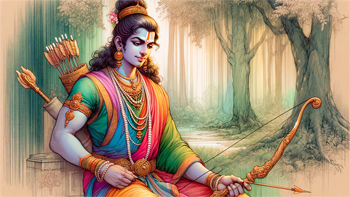In the heart of Hinduism lies the enduring tale of Lord Rama, an avatar of the god Vishnu and the protagonist of the ancient Indian epic, the Ramayana. Rama's life story is more than a mythical narrative; it's a blend of moral principles, dutiful righteousness, and profound spirituality. His character embodies the ideal qualities of manhood, making him a revered figure in Hindu culture and religious practices. Through the epic journey of Rama, the Ramayana imparts valuable lessons on dharma (duty and righteousness), devotion, and the complexities of human virtues.
Rama's story, set in the Treta Yuga, one of the four great epochs in Hindu belief, has been passed down through generations, capturing the hearts and minds of millions. His tale is not just central to Hindu mythology but also plays a significant role in shaping the moral and ethical fabric of Hindu society. This article delves into the life, virtues, and the enduring legacy of Lord Rama, offering insights into why he remains one of the most revered deities in Hinduism.
Birth and Early Life of Rama
Rama, the prince of Ayodhya, was born to King Dasharatha and Queen Kausalya. According to Hindu mythology, his birth was a divine event, fulfilling the promise of Vishnu to incarnate on earth to destroy evil. Rama, along with his brothers Lakshmana, Bharata, and Shatrughna, was trained in various arts, scriptures, and combat, excelling in all with his innate virtues and skills.
From an early age, Rama exhibited qualities of fairness, compassion, and unwavering commitment to dharma. His life in Ayodhya, before his exile, is marked by stories that showcase his righteousness and the deep love and respect he garnered from his people.
Rama's Exile and the Journey through the Forest
The turning point in Rama's life came with his fourteen-year exile, a result of court intrigue and his stepmother's wish to see her own son, Bharata, ascend the throne. Displaying his unflinching adherence to dharma and respect for his father's word, Rama accepted the exile with humility, accompanied by his wife Sita and his devoted brother Lakshmana.
This period in the forest is filled with numerous adventures and challenges. Rama and Lakshmana encountered and defeated several demons, protecting sages and innocents. The most significant event during this exile was the abduction of Sita by Ravana, the demon king of Lanka, which led to the epic war described in the Ramayana.
The Battle of Lanka and the Rescue of Sita
Rama's journey to rescue Sita is a tale of bravery, alliances, and divine interventions. He formed an alliance with Hanuman and the vanara (monkey) army, building a bridge to Lanka. The ensuing battle saw Rama vanquishing Ravana, thus rescuing Sita. This victory is celebrated as Dussehra or Vijayadashami in Hindu culture, symbolizing the triumph of good over evil.
Rama's return to Ayodhya with Sita and Lakshmana marked the beginning of Ramarajya, an era of ideal governance and righteousness. His reign as king is depicted as a period of prosperity, justice, and harmony, exemplifying ideal kingship.
Rama's Virtues and His Role as a Moral Beacon
Rama's life story is a guide to virtuous living. His adherence to dharma, even in the face of immense personal hardship, sets him apart as an ideal hero. He is often referred to as 'Maryada Purushottam' (the perfect man) for upholding the principles of duty, loyalty, and moral integrity.
In Hindu culture, Rama's character teaches the importance of responsibilities over personal desires, truth over falsehood, and communal well-being over individual gain. His respect for elders, devotion to his subjects, and love for his family are qualities that continue to inspire and guide.
The Enduring Legacy of Lord Rama in Hinduism and Beyond
The story of Rama has transcended religious scriptures to become an integral part of Indian culture and consciousness. His life and teachings have been interpreted in various art forms, literature, and festivals. Rama Navami, the celebration of his birth, and Diwali, marking his return to Ayodhya, are prominent Hindu festivals celebrated with great fervor.
Beyond the religious sphere, Rama's story has been a source of artistic and philosophical inspiration. From classical dance dramas to modern interpretations in film and literature, the narrative of Rama continues to resonate with diverse audiences, embodying timeless virtues and moral principles.
In essence, Lord Rama's story is not just a chapter in Hindu mythology; it is a living narrative that continues to influence the moral and spiritual fabric of society. His life, embodying the ideals of dharma, bravery, and virtue, remains a beacon of guidance and inspiration, reflecting the core values of Hinduism and its profound impact on human life and culture.
